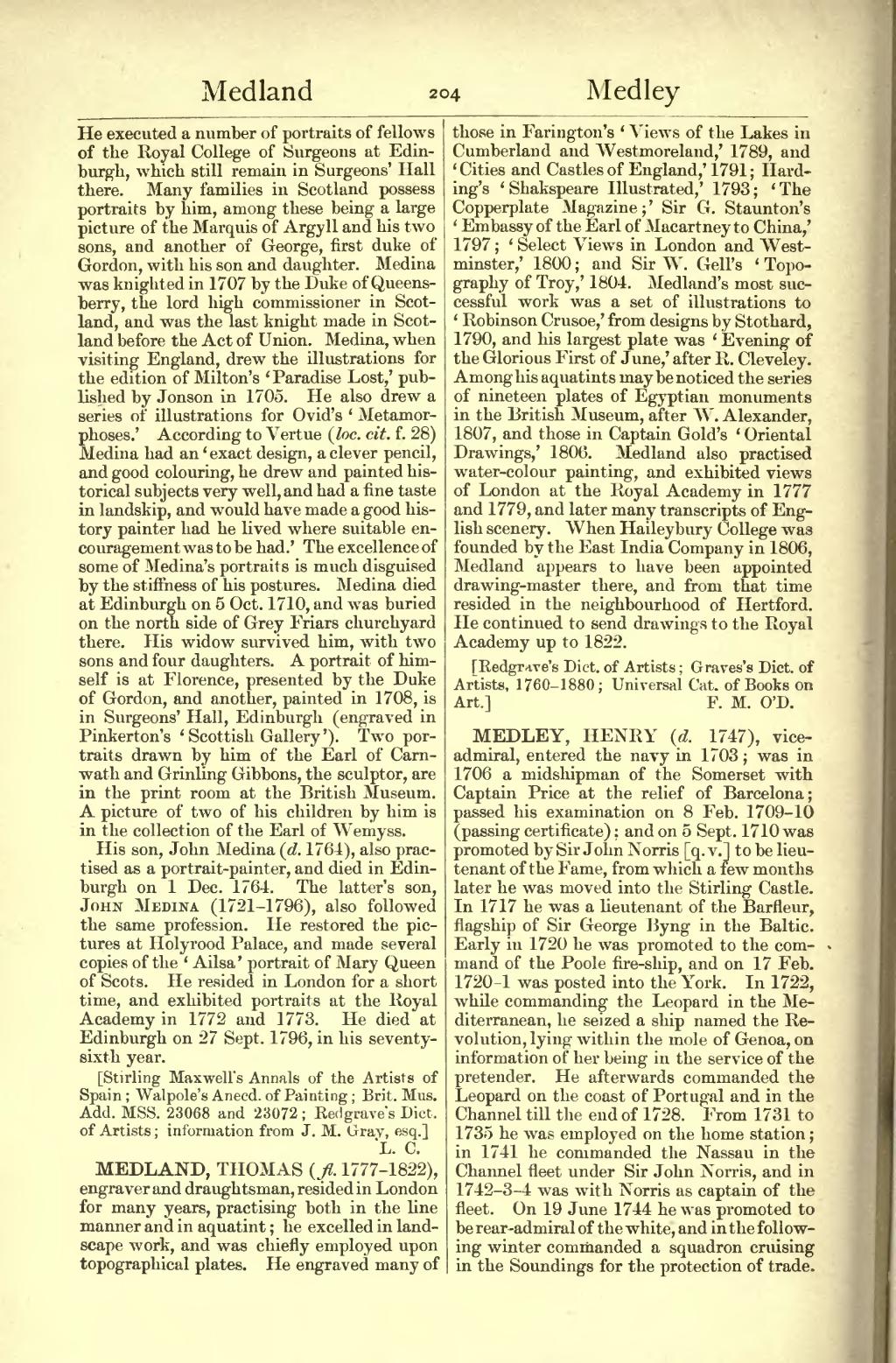He executed a number of portraits of fellows of the Royal College of Surgeons at Edinburgh, which still remain in Surgeons' Hall there. Many families in Scotland possess portraits by him, among these being a large picture of the Marquis of Argyll and his two sons, and another of George, first duke of Gordon, with his son and daughter. Medina was knighted in 1707 by the Duke of Queensberry, the lord high commissioner in Scotland, and was the last knight made in Scotland before the Act of Union. Medina, when visiting England, drew the illustrations for the edition of Milton's ‘Paradise Lost,’ published by Jonson in 1705. He also drew a series of illustrations for Ovid's ‘Metamorphoses.’ According to Vertue (loc. cit. f. 28) Medina had an ‘exact design, a clever pencil, and good colouring, he drew and painted historical subjects very well, and had a fine taste in landskip, and would have made a good history painter had he lived where suitable encouragement was to be had.’ The excellence of some of Medina's portraits is much disguised by the stiffness of his postures. Medina died at Edinburgh on 5 Oct. 1710, and was buried on the north side of Grey Friars churchyard there. His widow survived him, with two sons and four daughters. A portrait of himself is at Florence, presented by the Duke of Gordon, and another, painted in 1708, is in Surgeons' Hall, Edinburgh (engraved in Pinkerton's ‘Scottish Gallery’). Two portraits drawn by him of the Earl of Carnwath and Grinling Gibbons, the sculptor, are in the print room at the British Museum. A picture of two of his children by him is in the collection of the Earl of Wemyss.
His son, John Medina (d. 1764), also practised as a portrait-painter, and died in Edinburgh on 1 Dec. 1764. The latter's son, John Medina (1721–1796), also followed the same profession. He restored the pictures at Holyrood Palace, and made several copies of the ‘Ailsa’ portrait of Mary Queen of Scots. He resided in London for a short time, and exhibited portraits at the Royal Academy in 1772 and 1773. He died at Edinburgh on 27 Sept. 1796, in his seventy-sixth year.
[Stirling Maxwell's Annals of the Artists of Spain; Walpole's Anecd. of Painting; Brit. Mus. Add. MSS. 23068 and 23072; Redgrave's Dict. of Artists; information from J. M. Gray, esq.]
MEDLAND, THOMAS (d. 1833), engraver and draughtsman, resided in London for many years, practising both in the line manner and in aquatint; he excelled in landscape work, and was chiefly employed upon topographical plates. He engraved many of those in Farington's ‘Views of the Lakes in Cumberland and Westmoreland,’ 1789, and ‘Cities and Castles of England,’ 1791; Harding's ‘Shakspeare Illustrated,’ 1793; ‘The Copperplate Magazine;’ Sir G. Staunton's ‘Embassy of the Earl of Macartney to China,’ 1797; ‘Select Views in London and Westminster,’ 1800; and Sir W. Gell's ‘Topography of Troy,’ 1804. Medland's most successful work was a set of illustrations to ‘Robinson Crusoe,’ from designs by Stothard, 1790, and his largest plate was ‘Evening of the Glorious First of June,’ after R. Cleveley. Among his aquatints may be noticed the series of nineteen plates of Egyptian monuments in the British Museum, after W. Alexander, 1807, and those in Captain Gold's ‘Oriental Drawings,’ 1806. Medland also practised water-colour painting, and exhibited views of London at the Royal Academy in 1777 and 1779, and later many transcripts of English scenery. When Haileybury College was founded by the East India Company in 1806, Medland appears to have been appointed drawing-master there, and from that time resided in the neighbourhood of Hertford. He continued to send drawings to the Royal Academy up to 1822.
[Redgrave's Dict. of Artists; Graves's Dict. of Artists, 1760–1880; Universal Cat. of Books on Art.]
MEDLEY, HENRY (d. 1747), vice-admiral, entered the navy in 1703; was in 1706 a midshipman of the Somerset with Captain Price at the relief of Barcelona; passed his examination on 8 Feb. 1709–10 (passing certificate); and on 5 Sept. 1710 was promoted by Sir John Norris [q. v.] to be lieutenant of the Fame, from which a few months later he was moved into the Stirling Castle. In 1717 he was a lieutenant of the Barfleur, flagship of Sir George Byng in the Baltic. Early in 1720 he was promoted to the command of the Poole fire-ship, and on 17 Feb. 1720–1 was posted into the York. In 1722, while commanding the Leopard in the Mediterranean, he seized a ship named the Revolution, lying within the mole of Genoa, on information of her being in the service of the pretender. He afterwards commanded the Leopard on the coast of Portugal and in the Channel till the end of 1728. From 1731 to 1735 he was employed on the home station; in 1741 he commanded the Nassau in the Channel fleet under Sir John Norris, and in 1742–3–4 was with Norris as captain of the fleet. On 19 June 1744 he was promoted to be rear-admiral of the white, and in the following winter commanded a squadron cruising in the Soundings for the protection of trade.
